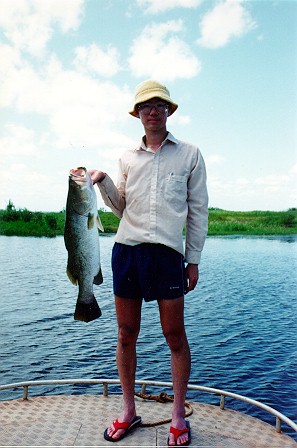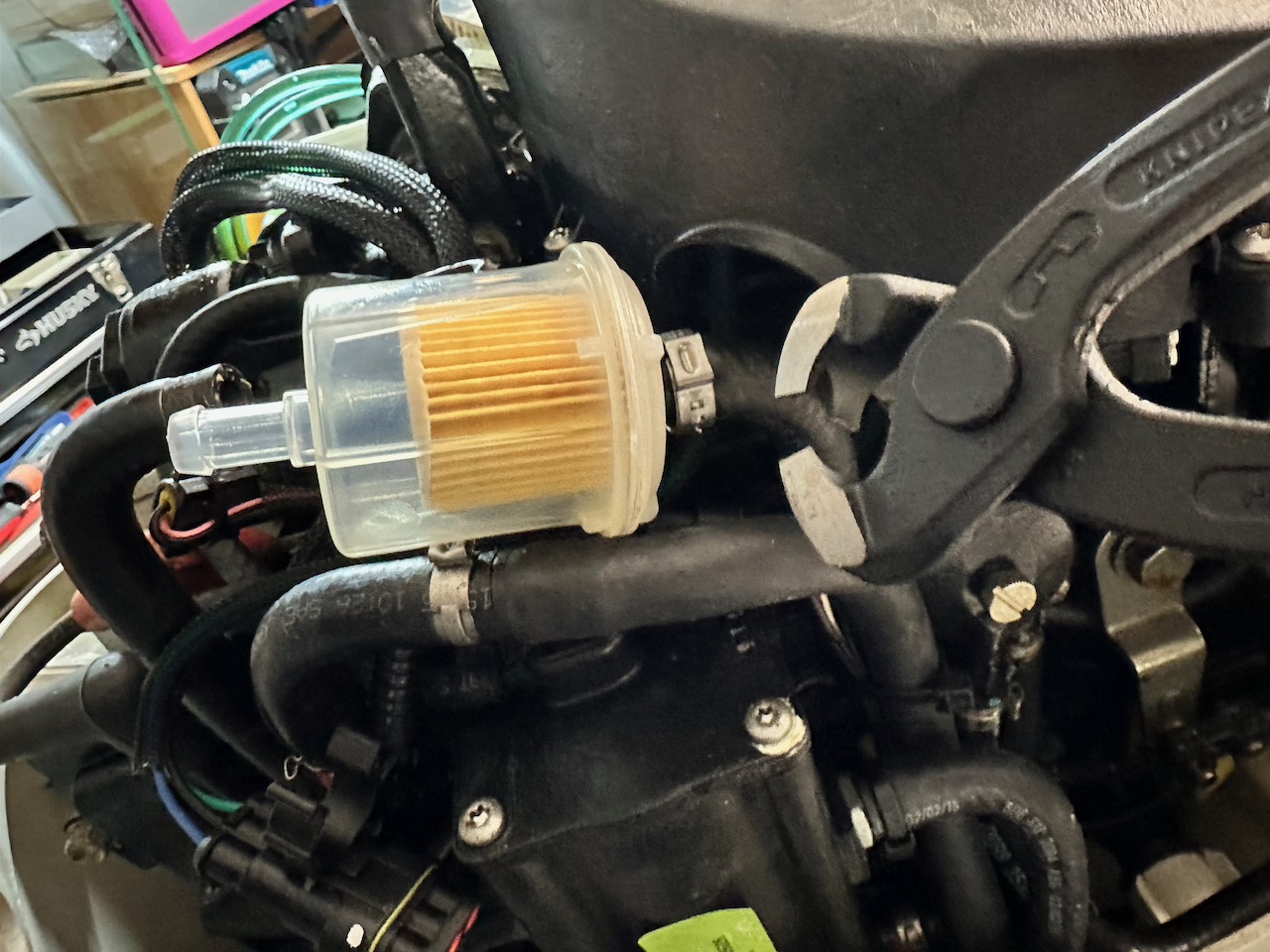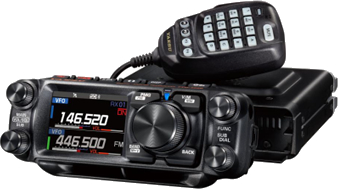Barramundi on Fly
Introduction

The Northern Territories (NT) of Australia is best known by fisherman for excellent barramundi fishing. The barramundi (or barra) can grow to enormous sizes (> 100 lb), but anything over 1m is considered a trophy fish. Barramundi are much like the American bass, they hide around snags and ambush their prey. They can be caught in both fresh and saltwater although the saltwater barramundi are usually better to eat. The barramundi is one of the premier Australian sportfish as when hooked it will usually make several headshaking jumps several feet about the water. For its size, it does not have the line pulling ability of fish such as tarpon, but the spectacular jumps, its predator instincts and its delicious flesh make up for this.
Fishing for barra is usually using lures like the Nilsmaster invincibles and spearheads. Most fishermen change the trebles that come on these lures as they are a bit weak for a good barramundi. They are replaced with stronger rings and trebles.
Fishing is usually done by slow trolling and by casting at snags. Most fishing is done in small punts (12-14 ft) with 15 hp outboards. These boats allow you to go into the shallow water which the barramundi frequent and are easy to trailer along the rough dirt roads which lead to most boat ramps. Boat ramps are usually dirt and there is a huge advantage in having a small boat which you can physically haul into the water if required.
Bank fishing is generally not the best way of catching barra for two reasons. Firstly, there is a large risk of being eaten by a saltwater crocodile. The crocodile is a protected species and they are in almost plague proportions in most barramundi waters. The other reason that bank fishing is not as popular is that barramundi are spread throughout the river and the boat gives much more freedom of movement on the water.
On the Mary river at the Shady Camp wall, the fishing rules are very strict, single hooks only (no trebles) and a bag limit of 2 fish. The minimum size fish is 55 cm which means that any legal fish is quite big (approx 4 lb).
The bag limit is especially cunning as after you have caught your bag limit, you are not allowed to fish any more even if you will release all the fish you catch. Thus most anglers keep their first legal fish to ensure that they have something to eat and then release all other fish and hope that they can catch one right at the end.
The Story
The “wall” at Shady Camp on the Mary River is one place where barramundi can be caught from the shore. The wall is lot of rocks which drop about 1 meter. On the topside of the wall at any time of the day, a huge school of small tarpon (1-3 lb) are always splashing about. These are a fun diversion from the real business of barra fishing, but they are actually considered a rubbish fish and you can catch as many tarpon as you like there, every cast will get hit by at least one if not two tarpon. Anybody can easily catch a dozen tarpon in 30 minutes and I did this on an earlier visit to the wall. On light tackle such as a 6 wt fly rod, these tarpon put up a good fight, especially in the strong current that is present at the wall. The trick is to lead them out of this current once hooked.
For saltwater fly fishing, a reel which has a good drag is essential and my #8 wgt rod was ideal. I used an 8 wgt Cortland 444 weight forward floating line. To this was tied about 9 ft of 12 lb mono as a leader and then a 10 inch 40 lb shock tippet. In retrospect, I could have used 8 lb leader, but I didn’t have anything but 12 lb monofilament with me at the time. I probably would have broken my rod before I broke my leader.
The fly that I used was a “pink thing”. This is described in Lefty Kreh’s saltwater fly patterns and is a very effective barramundi fly. I went up to the NT with pink things, orange and black deceivers, dahlberg divers and poppers. At the “wall”, I found that I only needed to use pink things. These were tied on size 1 Tiemco saltwater hooks (I think it was 800S) which are excellent and well worth the extra money as they come out of the box very sharp and you don’t need to worry about sharpening them.
We arrived at the Shady Camp wall at approximately 3:30pm and were pleased to see that nobody was fishing the wall at this time. This allowed us to get into the best fishing positions.
The water forms rapids on the wall and dumps fast flowing churned up water into the bottom part. At the right time of year, barramundi are present in large numbers on both the top and bottom side of the wall. I feel that the best position is to stand in the fast water flow and fish the bottom part of the wall right in front of the edge of the rapid water. From this position, sight fishing to barramundi is possible as they can be seen in the water. This position allows one to fish both the fast flowing water and the slack water as well.
Within a minute or two of my first cast, I felt a bump. When fishing for barra, you often first feel a bump before the strike. This is the barra trying to stun its prey with its gill rakers. When the weight of the fish was felt, I stripped the line back hard and then sharply brought the rod tip to the air. Unlike trout, I was told to try to pull its head off to set the hook in the hard mouth. The rod buckled and I was on to my first barramundi of the afternoon. The barramundi jumped about 3 ft clear of the water and then charged downstream with the flow of the current. My reel screamed as I held the rod above my head and slowly moved towards the bank to fight the fish.
I could see when the barra jumped that it was a decent fish. The first run took about 3/4 of the fly line and I tried to ease it out of the fast current. After the first run, I managed to get back about 3/4 of the line it took before it made another half hearted run. Soon, it was about 30 ft away and it jumped out of the water again angrily. When the barramundi jumps from the water, it shakes its head and can often dislodge lures from its mouth. I think that it has a much harder time dislodging a fly. However, it is especially to keep the line tight at all stages. When the fish was about 20 ft away, I could see it on the surface exhausted. I grabbed the fish on the bottom jaw and lifted it from the water. It was a pretty good fish, about 6 lb and I promptly bled it to keep it for dinner. The fight took about 10 min from hookup.
I went back to my spot and then cast my line to the same spot that I had caught my first fish. Within two strips, I was on again. This one caught me by surprise, and I had fly line all tangled everywhere. Since I was standing in the fast current, you cannot leave the fly line on the water at your feet. A stripping basket would be handy but I prefer to hold the line in loops. I had a barramundi on one end pulling the line tight and I was trying to undo the knots that was formed on my other hand, at the same time trying to keep the rod tip high to stop the fish from snagging the line on rocks! It took me about a minute to fix my line and I was glad I had a strong 12 lb leader on which the fish was not able to pop. I fought the fish in a similar manner to the first one and landed a just legal barramundi. I let this one go without taking it out of the water since if I kept it, that would be my bag limit and I would have to stop fishing.
The next fish was caught with only a little more effort than the first fish, however, this was a 9 lb barra and this too was released even though that was the biggest barra I had caught so far on fly.
I tied on a new shock tippet as the old one was getting a bit worn and then I returned to my spot. After about half a dozen casts and retrieves, I was hooked up yet again. At first I thought that it was a small fish as I was able to pull the fish about 20 ft towards me. Then the fish made its first run. It quickly ran out all of my fly line and about the same again of backing before it stopped. I started pumping it in and it made another run of about 50 ft. At this point, the fish was about 200 ft away and I was worried that it may get caught on rocks in the middle of the river. I applied heavy side pressure and managed to coax it away from the rocks but without gaining any line. The fish never jumped and I fought the fish for what seemed like an eternity. I had backed off on my drag a little to make sure I would not lose the fish because of too much pressure and the backing to fly line knot must have gone though the guides two or three times. Slowly but surely the fish was coming in, and I had a small audience watching me at this stage. I was pumping the fish in and peering anxiously into the water to try to catch a glimpse of the size of the fish. About 10 runs later, I finally saw the fish, and to my disappointment, it was only small. When it reached the shore, I could see why. The fish had been foul hooked on a small flap of skin, just on the shoulder. I released the fish and returned again to the wall.
I caught a few more fish after that. About 30 minutes before sunset, too many people were crowding around me (all lure fishing with baitcasters) and they didn’t leave me enough room to cast properly. Since I had already caught a few fish, I decided to call it a day.
My friend who had been fishing the other side of the river soon came along with a fish the same size as mine. He had caught a few on a red Mr Twister. We cleaned the fish and left Shady Camp just before dark, having spent a little over two hours fishing.



